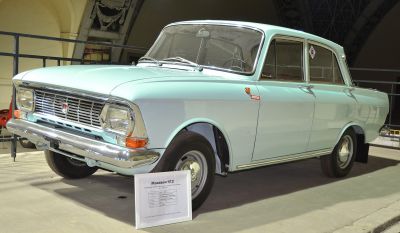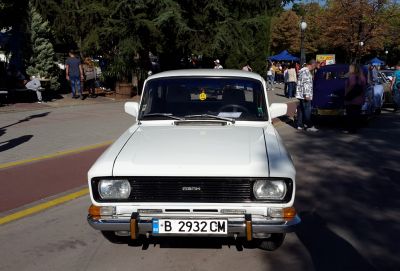 1976 Moskvich 2140 Dimensions, Size & Specs
1976 Moskvich 2140 Dimensions, Size & Specs
Measurements of the 1976 Moskvich 2140, engineered for optimal performance and comfort
| Dimensions | |
|---|---|
| Length: | 4250 mm167.3 in13.9 ft |
| Width: | 1550 mm61.0 in5.1 ft |
| Height: | 1480 mm58.3 in4.9 ft |
| Weight Specifications | |
| Curb Weight: | 1080 kg2381 lbs |
| Tire Specifications | |
| Tire Size: |
|
The Moskvich 2140 is a classic sedan produced by the Soviet manufacturer Moskvich from 1976 until 1988. As a hallmark of Soviet automotive engineering during this period, the 2140 generation sedan offers a blend of utilitarian design and sturdy construction. The vehicle measures 4250 mm (167.3 inches) in length, positioning it within the compact sedan segment of its era. Its width is 1550 mm (61 inches), providing sufficient cabin space while maintaining a modest footprint suited for urban and rural roads alike. The height stands at 1480 mm (58.3 inches), contributing to a balanced profile that ensures comfortable headroom inside the cabin. Weighing in at 1080 kg (2381 lbs), the Moskvich 2140 maintains a relatively light curb weight, which aids in its fuel efficiency and maneuverability. The car rides on 165/80 R13 tires, a size that complements its overall build, delivering adequate road grip and ride comfort. The 2140 sedan is known for its reliability and ease of maintenance, characteristics highly valued in its production markets. Its dimensions reflect an efficient use of space, providing enough interior room while remaining compact enough for city driving challenges. This combination of moderate size and solid performance has made the Moskvich 2140 a notable example among Soviet cars of the late 20th century, making it a subject of interest for collectors and enthusiasts who appreciate automotive history and compact sedan design.
Discover the standout features that make the 1976 Moskvich 2140 a leader in its class
Have a question? Please check our knowledgebase first.
The Moskvich 2140 sedan, produced between 1976 and 1988, measures 4250 mm (167.3 inches) in length, 1550 mm (61.0 inches) in width, and 1480 mm (58.3 inches) in height. These dimensions reflect its compact and practical design typical for sedans of its era, offering a balanced profile suitable for urban and suburban driving conditions.
The Moskvich 2140 has a curb weight of approximately 1080 kg (2381 lbs). This weight is relatively light compared to many contemporary mid-sized sedans, which helps with fuel efficiency and maneuverability. The weight distribution contributes to modest performance and handling, which was standard for cars designed in the Soviet automotive context during the 1970s and 1980s.
The Moskvich 2140 is equipped with 165/80 R13 tires. These tires are 165 mm in width with a sidewall height that is 80% of the tire width, mounted on 13-inch diameter rims. This tire size balances ride comfort with adequate grip and was common for compact sedans of its time. The relatively narrow width contributes to lower rolling resistance, aiding fuel economy but limiting cornering grip compared to wider modern tires.
The Moskvich 2140’s compact dimensions—4250 mm (167.3 inches) long and 1550 mm (61.0 inches) wide—make it suitable for parking in a standard single-car garage, which typically measures around 2.4 to 3 meters (7.9 to 9.8 feet) in width and 5.4 to 6 meters (17.7 to 19.7 feet) in length. Its relatively modest height of 1480 mm (58.3 inches) also means it easily fits under most garage doors and ceiling heights.
Compared to its predecessor, the Moskvich 408, the Moskvich 2140 remains quite similar in overall size but incorporates some design refinements. The 2140 is slightly longer and generally improved in interior space utilization, while maintaining a comparable width and height. Both models share similar compact sedan proportions, with the 2140 focusing more on comfort and updated aesthetics to align with late 1970s design standards.
Dimensionally, the Moskvich 2140 fits the profile of a compact sedan typical of the Eastern European automotive market during the 1970s and 1980s. Its length of 4250 mm (167.3 in), width of 1550 mm (61.0 in), and height of 1480 mm (58.3 in) make it smaller than many Western counterparts like the Ford Escort or Volkswagen Golf of the era, which often featured slightly larger footprints. This compactness reflects a focus on efficiency and practicality rather than luxury or high performance.
The Moskvich 2140 was designed to maximize passenger space within its compact 4250 mm length and 1550 mm width. While it offers seating for five passengers, interior space is modest by modern standards but was on par with other sedans in its class. The cabin prioritizes utilitarian features and durability, with sufficient legroom and headroom for front and rear occupants, making it a practical choice for families of its time.
The Moskvich 2140 stands 1480 mm (58.3 inches) tall, providing a low center of gravity that benefits stability and handling. While precise ground clearance figures vary, typical sedans of this class have moderate clearance to navigate urban roads and light rural conditions. The design optimizes everyday usability, balancing comfort and drivability without compromising on accessibility or ease of entry and exit.
The Moskvich 2140 typically comes equipped with a 1.5 to 1.6-liter inline-four petrol engine, producing moderate power suitable for daily commuting and modest highway cruising. Its engineering focuses on reliability and ease of maintenance rather than high performance. The car delivers steady acceleration and straightforward mechanical operation, appealing to practical users in the Soviet era and beyond.
Fuel efficiency for the Moskvich 2140 is moderate given its era and design, often averaging around 8 to 10 liters per 100 kilometers (approximately 23 to 29 miles per gallon). Maintenance is relatively straightforward due to its simple mechanical setup, with parts generally durable and widely available in regions where the car was popular. The vehicle is known for its ruggedness and ease of repair, making it a practical choice for owners valuing low running costs.
Discover similar sized cars.

| Production: | 1967-1969 |
|---|---|
| Model Year: | 1967 |
| Length: | 4250 mm167.3 in |
| Width: | 1550 mm61.0 in |
| Height: | 1480 mm58.3 in |

| Production: | 1969-1976 |
|---|---|
| Model Year: | 1969 |
| Length: | 4250 mm167.3 in |
| Width: | 1550 mm61.0 in |
| Height: | 1480 mm58.3 in |

| Production: | 1976-1987 |
|---|---|
| Model Year: | 1976 |
| Length: | 4250 mm167.3 in |
| Width: | 1550 mm61.0 in |
| Height: | 1480 mm58.3 in |

| Production: | 1978-1988 |
|---|---|
| Model Year: | 1978 |
| Length: | 4250 mm167.3 in |
| Width: | 1550 mm61.0 in |
| Height: | 1480 mm58.3 in |
